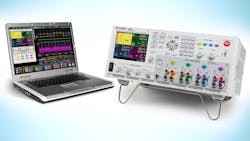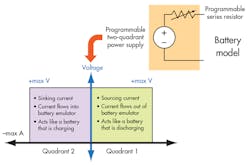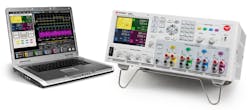Simulating a Battery with a Power Supply Reaps Benefits
This file type includes high resolution graphics and schematics when applicable.
In our mobile world, more devices are “cutting the cord” and running off batteries. Thanks to increases in battery power density and advanced power-management techniques, even power-hungry devices now have battery-powered versions. From tiny energy-harvesting devices to the ubiquitous smartphone to household tools/appliances to pure electric vehicles, batteries abound in all shapes and sizes.
R&D engineers, when developing these battery-powered devices, can’t rely on batteries for their day-to-day testing. Using only batteries, how can an engineer prove the design of a battery-powered device at the battery’s various states-of-charge? This would require an array of batteries all preset to various states-of-charge. Once used for the test, each specifically charged battery would need to be restored to that same state-of-charge in preparation for its next use. This is possible, though quite impractical.
Instead, testing can be done using a single real battery, but this requires the R&D engineer to prepare the battery to the proper state-of-charge for each test. The battery must be charged or discharged to get to the proper state-of-charge for the test, which is time-consuming.
Such significant battery-preparation time can be avoided by using a programmable electronic battery, also known as a battery emulator. The battery emulator reduces test setup time, creates a safer test environment, and provides more repeatable results compared to using a real battery during test.
Safer Testing
Batteries, especially newer lithium-ion designs, contain high amounts of stored energy. Under normal operating conditions (temperature, charge rates, discharge rates), batteries are safe to use. But during test, unexpected conditions can occur. A DUT in design stage may not function properly and cause overcharging or overdischarging of the battery. Even worse, the DUT may fail or go into an unexpected state, which could draw excessive current from the battery, creating risk of fire, explosion, and chemical spill.
In contrast, a battery emulator is a much safer option than a real battery. Battery emulators contain electronic protection circuits, like overvoltage and overcurrent protection, which can interrupt a test that has gone awry. By removing the real battery from the test, DUT malfunctions will not lead to battery-related hazards.
Better Repeatability
Continually cycling batteries can cause inconsistent test results and reduced battery life. It’s difficult to guarantee the exact state-of-charge when manually preparing the battery to the desired state-of-charge. Normally, this is accomplished by fully discharging the battery, then recharging the battery to the desired state-of-charge. This results in extra cycling of the battery and accelerates aging. Battery behavior changes as the battery age—over time, an R&D engineer cannot be sure about reaching the desired state-of-charge of the aging battery. Consequently, inaccurate results may occur with tests run using that aging battery.
A battery emulator will give more consistent and repeatable test results compared to using a real battery for testing. It removes the uncertainty associated with battery aging and determining the state-of-charge of the battery.
Use a Power Supply to Emulate a Battery
A power supply can be used for the programmable battery. However, a typical power supply has three characteristics that make it unlike a battery and, therefore, unsuitable for battery emulation. First, a power supply tends to maintain very low and constant output impedance. Second, the power supply never runs down. Third, a power supply is a power source, but a battery can both source power (as it discharges) and absorb/sink power (as it charges). Thus, a power supply fundamentally is not equivalent to a battery.
Batteries can be modeled as a two-quadrant voltage source along with a series resistance (Fig. 1). The output voltage and the resistance are reprogrammed to simulate the effects of state-of-charge and battery aging.
By directly setting the voltage and internal resistance, the battery emulator can instantly represent any desired state-of-charge, eliminating battery charging or discharging to preset to the correct state-of-charge before testing. Testing conditions that would be dangerous to a battery can be safely and repeatedly simulated, including applying short circuits or overcurrent, overvoltage, overcharge, and overdischarge conditions.
Perhaps the most complex part of the battery emulation is to simulate how the voltage changes with state-of-charge. This relationship is a basic model of a battery and depends greatly on battery chemistry and battery design. A sophisticated battery emulator may be able to accept a downloaded battery model (example: send instruction to the emulator to act like a battery model 1234A from battery vendor XYZ). Alternatively, the battery emulator can accept a table of values of state-of-charge (in percent) versus output voltage. In the battery-emulator control system, it will monitor how much charge flows into or out of the battery emulator (i.e., coulomb counting), adjust the state-of-charge, and then lookup the appropriate new output voltage based on the always updating state-of-charge.
However, even without this sophisticated model-based control, a battery emulator can still work properly. Since the change in voltage is generally slow, a PC-based application can simply reprogram the output voltage to the desired value. The programmed voltage can be raised, or slewed, at a very slow rate, emulating the increase in voltage when a battery charges, or slowly drop the voltage to emulate the decrease in voltage during battery discharge.
This file type includes high resolution graphics and schematics when applicable.
Summary
Using a battery emulator accelerates test results, offers enhanced safety, and provides a more consistent test compared to testing using a real battery. Keysight Technologies makes a variety of power supplies that can act as battery emulators, featuring two-quadrant operation and programmable output resistance (Figs. 2 and 3).
About the Author
Bob Zollo
Solution Architect for Battery Testing, Electronic Industrial Solutions Group
Bob Zollo is solution architect for battery testing for energy and automotive solutions in the Electronic Industrial Solutions Group of Keysight Technologies. Bob has been with Keysight since 1984 and holds a degree in electrical engineering from Stevens Institute of Technology, Hoboken, N.J. He can be contacted at [email protected].






